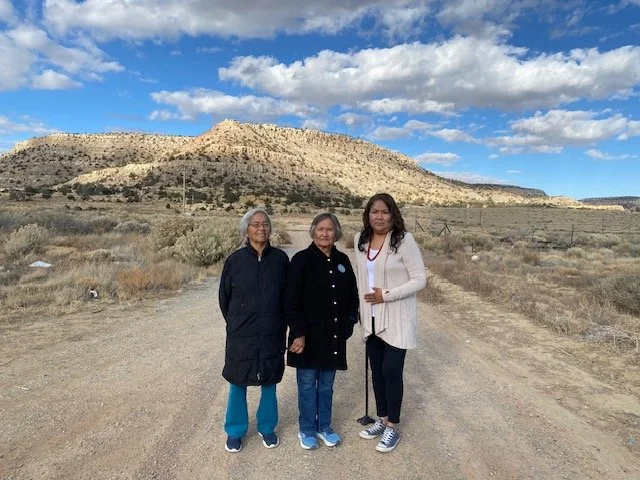Atomic Legacy on Route 66
Grade levels: 9-12
Lesson Plan Overview: Many people have heard of atomic bomb and nuclear energy development, but fewer people know about the communities that lived on or near the nuclear test sites, nuclear technology facilities, and the mines where uranium was extracted. These communities are often in the Southwest, and many were on or near Route 66. This lesson plan focuses on the personal stories of the people affected by the development of nuclear technology in those communities. It features two short documentaries. The first is about the Red Water Pond Community, members of the Navajo Nation, who are fighting to have the government clean up their land after it was contaminated by a nearby uranium mine. The second is the oral histories of people from Winslow, Arizona who lived near or “downwind” from a nuclear test site. There is also a reading about uranium mining from the EPA, a primary source activity examining newspaper articles, a writing assessment, and a reflection worksheet. All activities include graphic organizers or questions to guide student learning.
MATERIALS
Presentation for Lesson Plan
Reading: Radioactive Waste From Uranium Mining and Milling
Video Notes: Atoms for Peace & Nuclear Safety
Video Notes: Red Water Pond Community
Primary Source Analysis: Newspaper jigsaw activity
Worksheet: Who are the Downwinders?
Video Notes: The Impact of Nuclear Activities in Winslow
Writing assessment: Personal Histories of Atomic Downwinders
EXTENSION ACTIVITIES
The EPA offers a comprehensive lesson plan about the effects of uranium mining and nuclear development in RadTown Classroom Materials: Uranium
Another personal history from someone affected by atomic testing: “A Utah Resident Remembers Atomic Testing in 1950s Nevada”
Listen to an interview with Joan Hinton who worked for the Manhattan Project.
Other articles about uranium mining in the Southwest:
ALIGNMENT WITH STANDARDS
ELA Common Core Standards:
W.9-10.3: Write narratives to develop real or imagined experiences or events using effective technique, relevant descriptive details, and well-structured event sequences.
W.9-10.4: Produce clear and coherent writing in which the development, organization, and style are appropriate to task, purpose, and audience.
W.9-10.5: Draw evidence from literary or informational texts to support analysis, reflection, and research.
W.9-10.7: Conduct short as well as more sustained research projects to answer a question (including a self-generated question) or solve a problem; narrow or broaden the inquiry when appropriate; synthesize multiple sources on the subject, demonstrating understanding of the subject under investigation.
W.9-10.8: Gather relevant information from multiple authoritative print and digital sources, using advanced searches effectively; assess the usefulness of each source in answering the research question; integrate information into the text selectively to maintain the flow of ideas, avoiding plagiarism and following a standard format for citation.
W.9-10.9: Draw evidence from literary or informational texts to support analysis, reflection, and research.
L.9-10.2: Demonstrate command of the conventions of standard English capitalization, punctuation, and spelling when writing.
RH.9-10.1: Cite specific textual evidence to support analysis of primary and secondary sources, attending to such features as the date and origin of the information.
RI.9-10.7: Analyze various accounts of a subject told in different mediums (e.g., a person’s life story in both print and multimedia), determining which details are emphasized in each account
C3 Framework for Social Studies:
D2.His.3.9-12: Use questions generated about individuals and groups to assess how the significance of their actions changes over time and is shaped by the historical context.
D2.His.4.9-12. Analyze complex and interacting factors that influenced the perspectives of people during different historical eras.
D2.His.5.9-12. Analyze how historical contexts shaped and continue to shape people’s perspectives.
D2.His.12.9-12. Use questions generated about multiple historical sources to pursue further inquiry and investigate additional sources.
C3 Social Studies Standards:
D2.His.3.9-12: Use questions generated about individuals and groups to assess how the significance of their actions changes over time and is shaped by the historical context.
D2.His.5.9-12. Analyze how historical contexts shaped and continue to shape people’s perspectives.
D4.His.6.9-12. Use disciplinary and interdisciplinary lenses to understand the characteristics and causes of local, regional, and global problems; instances of such problems in multiple contexts; and challenges and opportunities faced by those trying to address these problems over time and place
D2.His.12.6-8. Use questions generated about multiple historical sources to identify further areas of inquiry and additional sources
All materials available in Google Drive and PDF formats.

